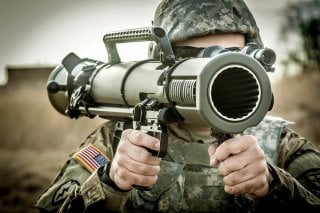The Carl Gustaf Rifle: How to Turn Any Solider Into A Mini Cannon
A favorite of paratroopers, special forces, and mountain warfare specialists, the Carl Gustaf recoilless rifle has been around for over 70 years. The M4 as it is commonly known today is prized for its relatively lightweight and can be operated by a single soldier.
A favorite of paratroopers, special forces, and mountain warfare specialists, the Carl Gustaf recoilless rifle has been around for over 70 years. The M4 as it is commonly known today is prized for its relatively lightweight and can be operated by a single soldier. In essence, recoilless rifles give individual soldiers some of the explosive potentials of small-bore artillery at the cost of range.
Carl Gustaf Recoilless Rifle: Explained
The crux of the Carl Gustaf is its recoilless design. Unlike traditional artillery which has bulky recoil mechanisms integrated into their design and are not man-portable, recoilless designs forgo this by venting some propellant from the rear of the rifle in order to counteract recoil caused by firing a large 84mm projectile. Though simple in principle, it requires a careful and exact propellant amount to ensure the rile platform does not go spinning off out of control but remains in place. A fascinating explainer on the principles of recoilless rifle operation can be seen here and is worth the watch.
Ideally, the Gustaf is operated by two soldiers, a gunner who carries and operates the rifle, as well as a loader who carries ammunition and acts as a spotter. Using a two-man crew, the Gustaf can sustain six rounds a minute, though in a pinch it can be operated by just a single gunner at the cost of a reduced rate of fire.
A coalition force member fires a Carl Gustav recoilless rifle system during weapons practice on a range in Helmand province, Afghanistan, Feb. 16, 2013. Coalition force members test fire various weapons systems on the range to check accuracy. (U.S. Army photo by Sgt. Benjamin Tuck/Released)[/caption]
The Carl Gustaf’s Swedish inventors intended their 84mm weapon to fill a similar role as the American Bazooka or the Nazi German Panzershreck had, namely a man-portable anti-armor and anti-fortification weapon. The design entered production in 1948, and though it came too late to see service in World War II, it quickly became of the most common anti-armor weapons at the squad level in many western militaries.
Since the original M1 Carl Gustaf entered service, several iterations have been subsequently introduced, focusing on lowering the weapon’s weight through the use of a carbon-fiber-reinforced steel liner barrel with the M3 version, to today’s M4, complete with a titanium-lined barrel. Improved ergonomics have also resulted in mating Picatinny rails to the barrel for better customization, and a slightly more compact weapon that aids maneuverability in confined, urban spaces, and has the additional benefit of further reducing the Carl Gustaf’s weight. The most updated variant weighs just 15 pounds, down from the original M1 design’s 31 pounds.
One of the other crucial advancements that have managed to keep the Carl Gustaf relevant has been the wide range of ammunition that is available for the platform, steadily updated to address advances in armored vehicle design. When introduced in the late 1940s, only two rounds were available, high-explosive, and high-explosive anti-tank. Now, however, a wide array of 11 types of ammunition are available, including area defense rounds, rocked-aided laser-guided ammunition, smoke, and illumination rounds.
The Carl Gustaf is prized not only by the Marine Corps, but also by some of the United States' special operations forces and the Army. Despite the Gustaf's old age, it won't be phased out any time soon.
Caleb Larson is a defense writer based in Europe. He holds a Master of Public Policy and covers U.S. and Russian security, European defense issues, and German politics and culture.

